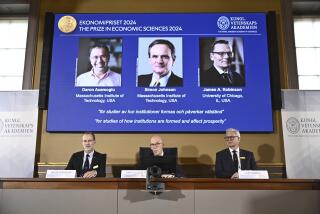3 U.S. scientists share Nobel Prize in medicine
Three U.S. scientists who discovered key aspects of how cells and animals age and how cancer cells become immortal have won the 2009 Nobel Prize in physiology or medicine.
Elizabeth Blackburn of UC San Francisco, Carol W. Greider of Johns Hopkins University School of Medicine and Jack W. Szostak of Harvard Medical School will share the $1.4-million award for their discovery of telomeres, small sections of DNA that protect the integrity of cellular DNA as animals and most other organisms age. They also discovered telomerase, the enzyme that manufactures telomeres and gives cancer cells their eternal life.
Ten women have won the Nobel in medicine in the past, but Monday’s announcement marked the first time that two have shared the prize in the same year.
The trio’s discoveries “have added a new dimension to our understanding of the cell, shed light on disease mechanisms, and stimulated the development of potential new therapies,” according to the Nobel citation.
All three received the proverbial call in the middle of the night informing them of their award. The award was not totally unexpected, however, because all three shared the Lasker Award in 2006 for their work. The American Laskers are generally viewed as a precursor of the Nobel.
Blackburn joked at a news conference that she went through five stages of happiness when the phone rang. “I went through ‘Where’s the phone?’; to disbelief; to dazed; to ‘I think it is sinking in now’; to ‘I am just so happy.’ ”
Greider said she was always up early for her exercise class and was folding laundry when the phone rang. “I didn’t make it to my spinning class today,” she said at a news conference. “My heart just really started racing.” She called the award “a real tribute to curiosity-driven research” that has no immediate clinical application.
As long ago as the 1930s, researchers recognized that there were structures at the end of each chromosome in the cell that appeared to protect the integrity of the DNA within the chromosome, much like the plastic tips on shoelaces keep them from fraying. But no one knew precisely what these structures, called telomeres, were and how they worked.
In her early work in the 1970s, Blackburn identified and decoded repeating segments of DNA at the ends of the chromosomes of the microorganism called Tetrahymena, but it was not clear what the segments did. Simultaneously, Szostak found that single strands of DNA injected into yeast cells were rapidly degraded.
The two got together and tried coupling Blackburn’s Tetrahymena segments to Szostak’s single strands of DNA. To their surprise, they reported in 1982, the Tetrahymena DNA protected the single-stranded DNA from being degraded by the yeast. This suggested a fundamental cellular mechanism was involved and, indeed, researchers subsequently showed that similar telomeres were present in the vast majority of microorganisms, plants and animals -- including humans.
Scientists now recognize that cells are created with a certain number of repeats of the fundamental DNA segment originally identified by Blackburn. Every time the cell replicates, a small segment is chipped off the DNA. As the number of repeats gets smaller, the cell ages and eventually dies.
Blackburn and Greider then began to investigate how telomeres were formed. On Christmas Day 1984, Greider first saw signs of an enzyme now known as telomerase, which synthesizes the DNA in telomeres, allowing cells to divide without losing telomere segments. Researchers subsequently found that cancer cells had high levels of telomerase activity, which allowed them to continue to divide indefinitely without aging.
Blackburn, 60, was born in Hobart, Tasmania, and earned her doctorate at the University of Cambridge in England. After postdoctoral study at Yale, she joined UC Berkeley, and switched to UC San Francisco in 1990. Always outspoken, she was fired in 2004 by President George W. Bush from his council on bioethics for her criticism of his restrictive policy on embryonic stem cell research.
Greider, 48, was born in San Diego and received her doctorate from Berkeley, where she studied under Blackburn. She joined Hopkins in 1997. She said: “The number of women doing high-powered research is quite remarkable, and the total number of Nobel prizes that have gone to women is lagging behind. But as more women head research projects, more will receive prizes.”
Szostak, 57, was born in London and grew up in Canada. He obtained his doctorate from Cornell in 1977 and has been at Harvard since 1979. He abandoned research on telomeres and is now focusing on the origins of life. “It was time to move on,” he said at a news conference.
More to Read
Sign up for Essential California
The most important California stories and recommendations in your inbox every morning.
You may occasionally receive promotional content from the Los Angeles Times.










